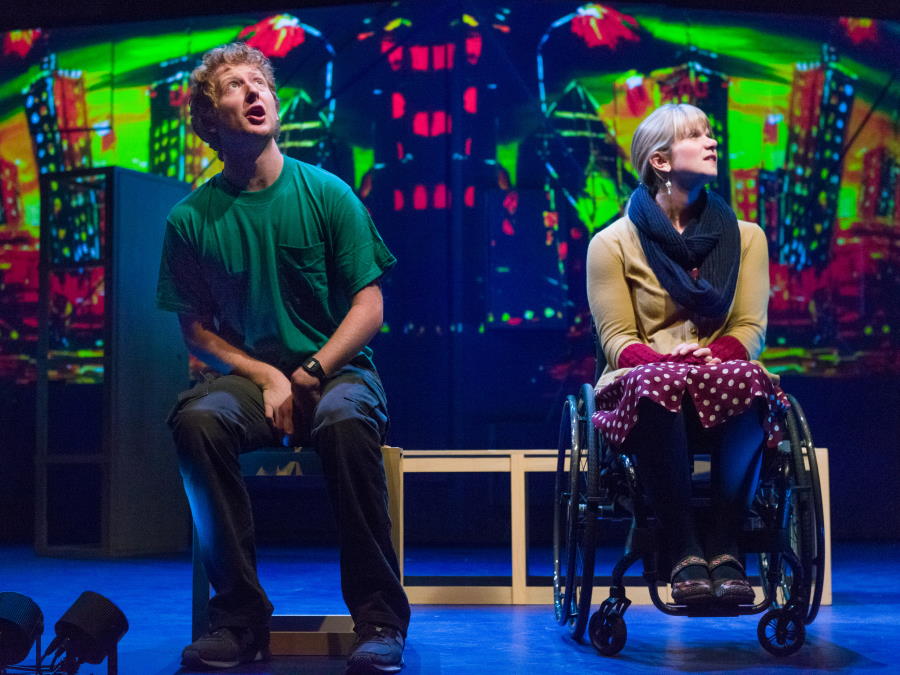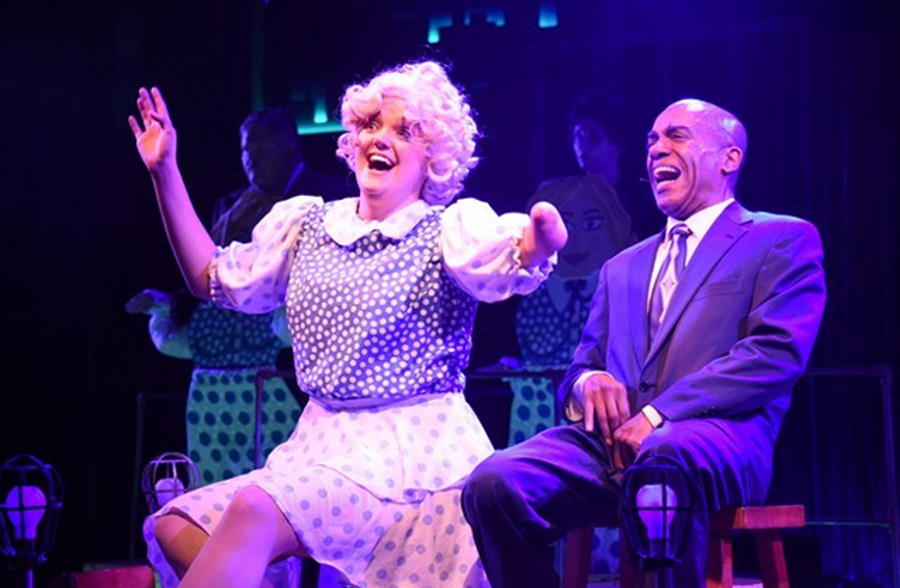This piece is one in a series on disability and theatre.
“It’s just a noisy hall where there’s a nightly brawl and all. That. Jazz.”
Less than five minutes into Chicago at Phamaly Theatre Company in Denver, I sat in my (front row, accessible) seat with tears rolling down my cheeks. If you know Chicago, you know that this is not a typical reaction to the show’s opening number, “All That Jazz.” But this evening was different. The stage was filled with disabled artists, singing, dancing, and actively defying disability tropes. At intermission, I read my large-print playbill, learning there were artists like me (an actor with low vision) on that stage. As I walked around the theatre and the lobby, I saw disabled individuals in the audience, working in patron services and sitting at lobby bar tables, enjoying a glass of intermission wine.
I released a deep exhale. For the first time in my 20 years as both a patron and a theatre artist, I felt true belonging.
This was the first time I watched another actor with low vision onstage. The first time I asked for a large-print playbill and had it simply handed to me. The first time I didn’t have to pay an extra $100 for a front row seat where I could see the show to the best of my ability.
But, I kept asking myself, why? Why did it take 20 years and a trip across the country for me to witness such radically inclusive theatre?
That evening fuels my work as a disability inclusion consultant. I help arts organizations and businesses develop a strategic plan for disability inclusion. I often encounter resistance. When I initially discuss disability inclusion strategy, I almost always hear, “We really want to be inclusive—it is just too costly and too complicated.”
To quote Velma and Roxie: Not nowadays.

I believe that if a theatre truly seeks to be inclusive, it will find a way. Theatres need to have a disability inclusion strategic plan in place, and it should work hand in hand with their operational strategic plan. There should be a line item for inclusion and accessibility efforts in every department’s budget. Inclusion initiatives are more likely to be implemented if department heads have the agency to address their own inclusion priorities and how the money can be spent.
A theatre will only create this kind of strategic inclusion plan, though, if it cherishes the existence and contributions of disabled people, not as an “extra” but as a core value. We must reframe the way we think about, talk about, and witness inclusive theatre. When disability theatre is synonymous with “special theatre,” it is clear that organizations do not recognize the disabled experience as central or valid. Theatres must work toward 360-degree disability inclusion, meaning that disability inclusion is a strategic priority, that people with disabilities can see themselves represented on- and offstage, and that disabled people have seats at the boardroom table.
As with most priorities in the theatre, this conversation turns naturally to questions of funding. Most arts organizations look to individual funders and foundations to help them build a more accessible and inclusive theatre. But the majority of this kind of funding is directed toward audience accessibility efforts. That approach overlooks opportunities to serve people on the stage and in other administrative roles.
’Cause you can look right through me…walk right by me…and never know I’m there.
Esther Grimm (she/her) is executive director of 3Arts, a Chicago nonprofit that supports and advocates for Chicago’s women artists, artists of color, and Deaf and disabled artists. She also noted that funding mostly focuses on audiences, not artists.
“There is a real dearth of development opportunities for disabled artists,” Grimm said. “While there may be disabled people in the audience, the question is whether they are ‘seeing’ themselves as central players on the stage (or as playwrights, designers, etc.).”
That development rightly begins, as it does for all theatre workers, at the educational level.
“The largest funding gap exists in the training of disabled artists, which is essential to the future of disability inclusion in the American theatre,” said Sara Morgulis (she/her), director of programs for Actionplay. This New York City-based nonprofit works to provide access to education, arts, and culture to people on the autism spectrum and with related disabilities. Addressing the needs of disabled artists at this early stage could be transformative, she said. “By investing in early-career training, we can provide disabled artists with the tools to succeed in their careers,” Morgulis said. “By supporting disabled writers, we can establish opportunities for more disability narratives to exist onstage, which will in turn create roles for disabled artists.”
Funding opportunities must not be viewed as one-offs but as real partnerships with benefits for both sides, according to New Jersey Arts Alliance executive director John McEwen (he/him). He emphasized that arts organizations should “look to the funder as a sounding board, someone with invaluable ideas, resources, and connections.” Arts organizations make a big mistake when they see a funder as a bank account. Relationships matter.
It’s a two-way street, though. As disabled people in theatre and entertainment endlessly repeat, “Nothing about us without us.” Disability inclusion consultant, actor, and activist Christine Bruno (she/her) wants funders and the field to hear and absorb an updated message: “Nothing without us.” This means if there is a grant-making panel, there should be a disabled person on that panel helping to make decisions.

Too often theatre companies seek funding in order for them to become inclusive. Instead, Minneapolis’s Mixed Blood Theatre, for one, uses its performances to address injustices and inequities and to effect change. The company’s work is consistently, intentionally inclusive—it’s built to be so, not tacked on as an afterthought. Artistic director Jack Reuler (he/him) said he wants the funding community to make demonstrating disability inclusion a criterion for arts organizations to apply for any funding in the first place. That would ensure that the commitment to this work is not conditional.
As an example, look no further than the New Jersey State Council on the Arts. It is the only state arts council in the nation that requires all grantees to submit board-approved ADA plans before an organization receives any funding.
Likewise, Mixed Blood demonstrates the way disability inclusion is woven into the framework of the organization: All shows are captioned, anyone can access audio description at any performance, and the company offers free transportation to and from the theatre. Additionally, anyone can see any show at Mixed Blood without cost. People with disabilities are in Mixed Blood’s audiences, on its board, and on its stages. This work shows a long-term commitment to a strategic inclusion plan that has evolved over time, and continues to evolve.
“Too costly and too complicated” simply can’t be an excuse for actively excluding more than 25 percent of the United States population from experiencing and participating in theatre. But both the cost and complication can’t be underestimated, and theatres that may just be adding disability to their inclusion dialogue for the first time must realize that this work takes careful planning and effort from all corners of the organization. A theatre’s disability inclusion plan or ADA plan cannot be delegated to its patron services manager or development director. Once the plan is in place and initial work is done, a theatre can assess additional needs and seek funding. Then that theatre must implement inclusion initiatives that are manageable and measurable.
And then the cycle continues. The work has no finish line.
A more accessible theatre isn’t just about people with disabilities. Think of the example of the curb cut: After the ADA was signed 30 years ago, curb cuts were mandated. But wheelchair users were not the only ones who benefitted from curb cuts; everyone did. Curb cuts made it easier and safer for everyone to travel from sidewalk to street. When we weave inclusion into the fabric of all we do in the theatre, we are contributing to a ripple effect of benefits for all people.
I urge you to join me and the theatre companies across the country who are leading the charge to build a more inclusive American theatre. As Velma sang: You’ve seen us goin’ through it. It may seem there’s nothin’ to it. But we simply cannot do it alone.
Alie B. Gorrie (she/her) is an actor, teaching artist, and disability inclusion consultant. She has performed in NYC, on tour, and regionally. She is also the producer of ABLE: a series, a documentary series discussing disability inclusion in TV, film, and theatre.
Creative credits for production photos: Chicago at Phamaly Theatre Company, songs by Fred Ebb and John Kander, book by Fred Ebb and Bob Fosse, based on a play by Maurine Dallas Watkins, with screen adaptation by David Thompson, directed by Regan Linton, with music direction by Donna Debreceni, choreography by Debbie Stark, Gab Barnett, & Ronni Stark, dramaturgy by Jordan Kaplan, set design by Nick Renaud, costume design by Nicole Harrison; lighting design by Dave Mazzeno, sound design by Jason Ducat, props design by Rob Costigan, and puppet design by Katy Williams. The Curious Incident of the Dog in the Nighttime at Mixed Blood Theatre, by Simon Stephens, based on the novel by Mark Haddon, directed by Jack Reuler, with movement direction by Brian Bose, costume design by Sara Ryung Clement, video design by Kathy Maxwell, sound design by Andrew Mayer, music by Eric Mayson, lighting design by Karin Olson, set design by Joseph Stanley, and props design by Abbee Warmboe.





